**The Art of Engraving: When Burin Meets Metal**
(Which Intaglio Technique Uses A Burin To Cut Lines Into A Metal Printing Plate?)
Ever wondered how artists create those incredibly detailed, crisp lines in old master prints? Think of Albrecht Dürer’s intricate works. The secret weapon? Engraving. This demanding technique relies on a simple yet powerful tool, the burin, to carve directly into metal. Let’s explore this fascinating world where pressure meets precision.
**1. What is Engraving?**
Engraving is a core intaglio printmaking method. Intaglio means the image is held in recessed lines below the plate’s surface. Engraving specifically uses a sharp, hardened steel tool called a burin. The artist pushes this burin across a polished metal plate, usually copper or zinc. The burin acts like a tiny plough. It cuts a V-shaped groove, or furrow, into the metal. This groove is the fundamental line that will hold the ink. Unlike drawing, the engraver needs significant physical pressure. They must control the burin’s depth and direction precisely. The resulting line can be thin and delicate or broad and powerful. This depends on the burin’s size and the force applied. The metal shavings curl away from the tool. These are scraped clear before inking. Engraving produces lines known for their sharpness, clarity, and potential for incredible detail.
**2. Why Choose Engraving?**
Artists pick engraving for distinct reasons. The primary reason is unmatched line control and precision. The burin allows for incredibly fine, clean lines. Artists can achieve subtle variations in line weight and texture. This precision is hard to match with other intaglio methods. Engraving creates lines with a characteristic sharpness and clarity. This is perfect for detailed work, cross-hatching for shading, and crisp textures. Engraved plates are incredibly durable. Copper plates, especially, can withstand very high print runs. The lines hold up well over time. This durability made engraving historically vital for reproducing artworks and maps. The direct physical act of cutting into metal offers a unique experience. Many engravers enjoy the tactile feedback. They feel the metal resisting the burin. This creates a strong connection between the artist’s hand and the final image. The resulting prints have a specific, often formal, aesthetic. This aesthetic is prized for its technical mastery and detail.
**3. How Engraving Works: The Process**
Creating an engraved print involves several careful steps. First, the artist prepares a smooth, polished metal plate. Copper is traditional and preferred for its workability. Zinc is a cheaper alternative. The artist then draws their design onto the plate. Sometimes they use a light sketch. Often they work directly, relying on skill. The engraver grips the burin firmly. They push it across the plate’s surface. The angle and pressure control the depth and width of the groove. Different burin tips create different line effects. Creating curves requires rotating the plate against the stationary tool. Shading is built through techniques like cross-hatching. This involves engraving sets of parallel lines crossing each other. After engraving the entire image, the plate is ready for inking. Thick, sticky ink is worked into *all* the engraved lines. The flat surface is then wiped meticulously clean. Only ink remains in the recessed grooves. A dampened sheet of paper is placed over the inked plate. Both pass through a high-pressure etching press. The pressure forces the paper into the inked grooves. The paper pulls the ink out. This creates the raised, inked line on the final print. The plate is re-inked and wiped for each impression.
**4. Applications of Engraving: Beyond Fine Art**
Engraving’s precision made it indispensable long before digital printing. Historically, it was crucial for reproducing artworks. Master engravings spread famous paintings across Europe. Engraving was the gold standard for detailed mapmaking for centuries. The sharp lines captured coastlines and topography perfectly. Banknotes and stock certificates relied heavily on engraving. The fine lines were extremely difficult to forge convincingly. Engraving produced high-quality illustrations for scientific books and important publications. Diplomas and prestigious certificates often featured engraved text and borders. While less common for mass production now, engraving remains vital in fine art printmaking. Many artists prize its unique line quality and physical challenge. Engraving is also used for creating high-end dies. These are used in processes like die-stamping for luxury packaging or metalworking. Personalization on items like trophies or jewelry often uses modern engraving tools. These trace their roots back to the burin.
**5. Engraving FAQs**
Here are answers to common questions about engraving:
* **Is engraving the same as etching?** No. Engraving is a drypoint method. The artist physically cuts the lines with a burin. Etching uses acid. The artist draws through a protective ground. The acid then bites the exposed metal lines. Engraved lines are sharper and cleaner than etched lines.
* **What does the burin look like?** A burin has a wooden handle. It holds a short, square or lozenge-shaped steel shaft. The tip is sharpened to a precise point. The angle of the bevel affects how it cuts the metal.
* **Why is copper the preferred metal?** Copper is relatively soft. It offers good resistance to the burin. It allows for smooth, controlled cuts. It holds fine details well. It’s also durable enough for many impressions. Zinc is softer and cheaper. It wears down faster. Steel is much harder. It is difficult to engrave by hand. Steel is used for industrial dies.
* **Can you correct mistakes in engraving?** Fixing mistakes is hard. Minor errors can sometimes be smoothed out with a scraper and burnisher. Significant mistakes usually mean starting that section over. Planning is essential.
(Which Intaglio Technique Uses A Burin To Cut Lines Into A Metal Printing Plate?)
* **What does an engraved line look like on the print?** Engraved lines are typically very sharp and clean. They have a consistent, slightly raised quality. They often start and end with a tapered point. The pressure of the burin creates a slight burr. This is much less pronounced than in drypoint. It gives the line a crisp, defined edge. Think of ink sitting neatly in a precise trough. Imagine dark chocolate perfectly filling a groove.
Inquiry us
if you want to want to know more, please feel free to contact us.


